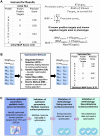ImmunoTar-integrative prioritization of cell surface targets for cancer immunotherapy
- PMID: 39932005
- PMCID: PMC11904301
- DOI: 10.1093/bioinformatics/btaf060
ImmunoTar-integrative prioritization of cell surface targets for cancer immunotherapy
Abstract
Motivation: Cancer remains a leading cause of mortality globally. Recent improvements in survival have been facilitated by the development of targeted and less toxic immunotherapies, such as chimeric antigen receptor (CAR)-T cells and antibody-drug conjugates (ADCs). These therapies, effective in treating both pediatric and adult patients with solid and hematological malignancies, rely on the identification of cancer-specific surface protein targets. While technologies like RNA sequencing and proteomics exist to survey these targets, identifying optimal targets for immunotherapies remains a challenge in the field.
Results: To address this challenge, we developed ImmunoTar, a novel computational tool designed to systematically prioritize candidate immunotherapeutic targets. ImmunoTar integrates user-provided RNA-sequencing or proteomics data with quantitative features from multiple public databases, selected based on predefined criteria, to generate a score representing the gene's suitability as an immunotherapeutic target. We validated ImmunoTar using three distinct cancer datasets, demonstrating its effectiveness in identifying both known and novel targets across various cancer phenotypes. By compiling diverse data into a unified platform, ImmunoTar enables comprehensive evaluation of surface proteins, streamlining target identification and empowering researchers to efficiently allocate resources, thereby accelerating the development of effective cancer immunotherapies.
Availability and implementation: Code and data to run and test ImmunoTar are available at https://github.com/sacanlab/immunotar.
© The Author(s) 2025. Published by Oxford University Press.
Figures






Update of
-
IMMUNOTAR - Integrative prioritization of cell surface targets for cancer immunotherapy.bioRxiv [Preprint]. 2024 Jun 6:2024.06.04.597422. doi: 10.1101/2024.06.04.597422. bioRxiv. 2024. Update in: Bioinformatics. 2025 Mar 04;41(3):btaf060. doi: 10.1093/bioinformatics/btaf060. PMID: 38895237 Free PMC article. Updated. Preprint.
Similar articles
-
IMMUNOTAR - Integrative prioritization of cell surface targets for cancer immunotherapy.bioRxiv [Preprint]. 2024 Jun 6:2024.06.04.597422. doi: 10.1101/2024.06.04.597422. bioRxiv. 2024. Update in: Bioinformatics. 2025 Mar 04;41(3):btaf060. doi: 10.1093/bioinformatics/btaf060. PMID: 38895237 Free PMC article. Updated. Preprint.
-
Identification of cell surface targets for CAR-T cell therapies and antibody-drug conjugates in breast cancer.ESMO Open. 2021 Jun;6(3):100102. doi: 10.1016/j.esmoop.2021.100102. Epub 2021 Apr 7. ESMO Open. 2021. PMID: 33838601 Free PMC article.
-
Associations on the Fly, a new feature aiming to facilitate exploration of the Open Targets Platform evidence.Bioinformatics. 2025 Mar 29;41(4):btaf070. doi: 10.1093/bioinformatics/btaf070. Bioinformatics. 2025. PMID: 39936578 Free PMC article.
-
Finding the Keys to the CAR: Identifying Novel Target Antigens for T Cell Redirection Immunotherapies.Int J Mol Sci. 2020 Jan 14;21(2):515. doi: 10.3390/ijms21020515. Int J Mol Sci. 2020. PMID: 31947597 Free PMC article. Review.
-
Recent advances and progress in immunotherapy of solid cancers.Adv Cancer Res. 2024;164:111-190. doi: 10.1016/bs.acr.2024.05.004. Epub 2024 May 31. Adv Cancer Res. 2024. PMID: 39306365 Review.
Cited by
-
Defining the extracellular matrix for targeted immunotherapy in adult and pediatric brain cancer.NPJ Precis Oncol. 2025 Jun 14;9(1):184. doi: 10.1038/s41698-025-00956-z. NPJ Precis Oncol. 2025. PMID: 40517137 Free PMC article.
References
MeSH terms
Grants and funding
LinkOut - more resources
Full Text Sources
Medical

